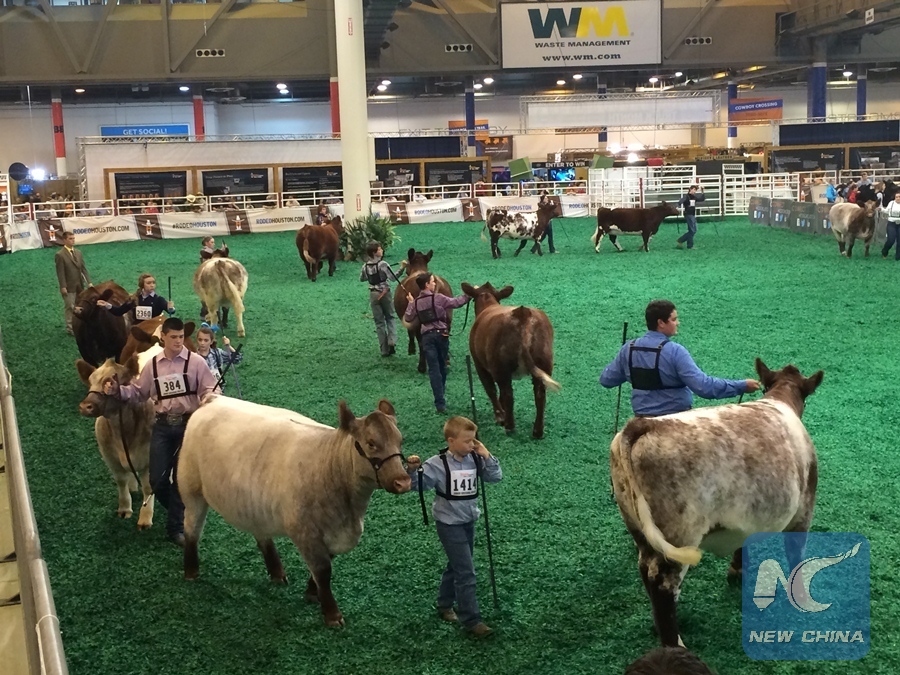
People walk around an arena with their cows before competitions during the 2016 HoustonLivestock Show and Rodeo in Houston, the United States, March 11, 2016. The Houston Livestock Show and Rodeo is held from March 1 to March 20 at the NRG Park in Houston. (Xinhua/Zhang Yongxing)
by Robert Stanton
HOUSTON, March 4 (Xinhua) -- Alex Prince is a choreographer, but his stage is not under the bright lights on Broadway. Instead, he directs a ballet of horseback riders and wagons that make up one of the 11 trail rides taking part in the 2018 Houston Livestock Show and Rodeo.
More than 3,000 trail riders from Texas and Louisiana arrived in Houston Feb. 27 to kick off the annual rodeo, which last year drew a record crowd of 2.6 million visitors. The rodeo runs through March 18.
An event this big - it's the world's largest livestock show and rodeo - is huge even by Texas standards. It's a family-friendly experience that educates and entertains the public, supports Texas youth, showcases Western heritage and provides year-round educational support in the community. Since it began in 1932, the rodeo has committed more than 450 million U.S. dollars to the youth of Texas.
In the weeks leading up to the rodeo, thousands of riders saddle up and hit the trails from all directions. With police escorts, the 11 trail rides wind their way to Houston to take part in a rodeo parade.
More than 30 floats, wagons and stagecoaches travel the parade route along downtown Houston streets. Along the route, floats are judged based on creativity, originality and presentation.
But the real Western experience can be found on the trail rides. The longest distance is covered by the Mission Trail Ride that begins nearly 400 kilometers away in San Antonio, Texas. All told, the trail rides cover a total of 2,150 kilometers on their journeys to Houston.
For Prince, now in his 23rd year as trail boss of the Southwest Trail Riders Association, it's all about safety, having fun, and helping others. Each year, the association awards 1,000 dollar scholarships to 15 students from Houston and the surrounding area.
The challenge on the trail, he said, is "orchestrating 250 people and the many others that ride with us daily from campsite to campsite." As the trail boss, Prince contacts property owners along the route to arrange use of their land for campsites, and he also makes lodging arrangements for the riders.
"We want people to enjoy themselves," Prince said. "The riders spent their time and money, and many plan their vacations to take part in the trail ride. This is symbolic of how the country was founded. There were no trains or planes. The mode of transportation was horses and wagons, and that's how families moved from one place to another."
Herman Murphy, affectionately known as "Punch" by his friends and family, knows first-hand the challenges of roughing it out on the trail, Old West style. He has been with the Southwest Trail Riders for 25 years.
"When I first started in 1993, all I had was a pickup truck and a horse trailer with a horse," Murphy said. "The horse would come out and I'd go into the trailer to sleep. As time evolved, I bought a motor home. I can rough it, but not the kids."
The most difficult part of being in a trail ride is Texas' unpredictable weather, especially in the spring time with frequent rain showers.
"You really never know how to prepare, especially with all the rain and mud, Murphy said. "Sometimes in the morning it's 70 degrees (21 degrees Celsius), and by lunchtime it drops to 30 (degrees) (-1 degree Celsius), and the wind is blowing and you're just miserable."
"When it's raining and cold and wet, your hands are so cold that you're holding onto the reins and at the end of the day you have to pry your hands off," he said. "Then at 4 a.m. you're back up and doing it again, because it's in your blood."
The trail rides represent picture of diversity, with doctors, lawyers, bankers, artists and people of all ages saddling up and taking part. Many of the trail rides include family members and generations of all ages.
During 20 days of rodeo, each night, thousands of visitors pour to see bull riding, calf roping and other livestock and horse show competition, and to check out nationally known music acts on stage. There's also an outdoor carnival with rides, and Texas-size plates of tamales, barbecue sandwiches, funnel cakes, corn dogs, pizza and just about everything else under the sun.

